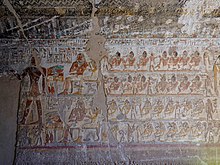Paheri
| Paheri in hieroglyphics | |||||
|---|---|---|---|---|---|
Paheri (Pa heri) P3 ḫrj The one from heaven |
|||||
Paheri (Pa her r [u] i) P3 ḥr r (w) j |
|||||
Paheri was a local ancient Egyptian prince in Elkab from the beginning of the 18th Dynasty ( New Kingdom - approx. 1500 BC).
supporting documents
Paheri is best known for his rock tomb in el-Kab . He was entitled " Mayor (ḥ3.tj-ˁ) of Elkab" and "Mayor of Armant ". Even his father was the "educator of the king's son" Iti-ru, so he had close ties to the royal family. Such a relationship is also documented for Paheri.
His grave
This grave was decorated with reliefs and is one of the best preserved of the early 18th dynasty . The tomb underscores the important role this city played at the beginning of this age. The burial place consists of the above-ground chapel, which in turn consists of a room and has a shaft in front of it that leads down to the burial chamber.
In the grave on the west wall there are mainly agricultural scenes and those that focus on death rituals, on the east wall there is a large banquet. On the back wall is a niche in which there are three statues depicting Paheri, his wife Henuterneheh and his mother Kemi. The rest of the wall has a large biographical inscription.
In this tomb, Paheri is also referred to as the “tutor of the king's son” and is depicted in a scene in which he carries Wadjmes (Wadjmose), the son of Thutmose I, on his lap. Another scene shows how Paheri sacrifices to Wadjmes and the other king's son Amunmose .
literature
- Joseph John Tylor: The Tomb of Paheri at El Kab. In: Édouard Naville : Ahnas el Medineh (Heracleopolis Magna). With chapters on Mendes, the Nome of Thoth, and Leontopolis. (= Memoir of the Egypt Exploration Fund. Volume 11, ISSN 0307-5109 ). Paul, Trench, Trübner, London 1894 (reprinted ibid. 1981, ISBN 0-901212-41-5 ), online .
Web links
| personal data | |
|---|---|
| SURNAME | Paheri |
| BRIEF DESCRIPTION | Prince of Elkab |
| DATE OF BIRTH | 16th century BC BC or 15th century BC Chr. |
| DATE OF DEATH | 16th century BC BC or 15th century BC Chr. |

